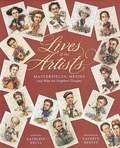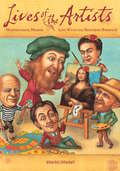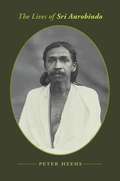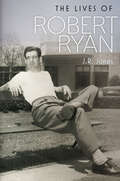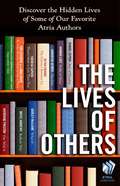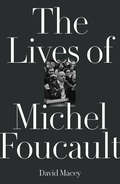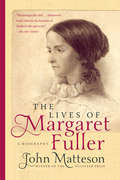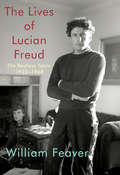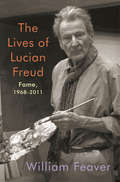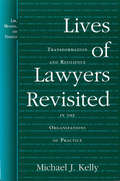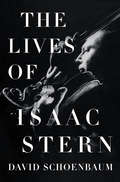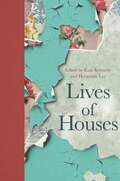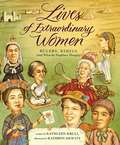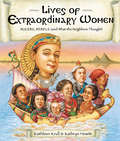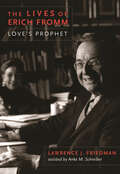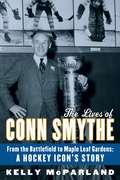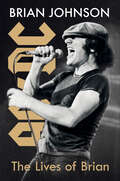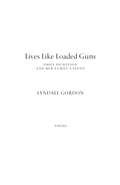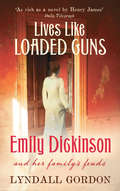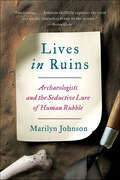- Table View
- List View
Lives of the Artists: Masterpieces, Messes (And What the Neighbors Thought)
by Kathleen KrullIn this entertaining, informative collection, readers discover the idiosyncrasies-- sometimes humorous, sometimes tragic-- of twenty famous artists, including Michelangelo, Cassatt, van Gogh, Kahlo, and Warhol. Fresh, spirited, and unconventional.
Lives of the Artists: Masterpieces, Messes (and What the Neighbors Thought)
by Kathleen Krull Kathryn HewittMost people can name some famous artists and recognize their best-known works. But what's behind all that painting, drawing, and sculpting? What was Leonardo da Vinci's snack of choice while he painted Mona Lisa’s mysterious smile? Why did Georgia O'Keeffe find bones so appealing? Who called Diego Rivera "Frog-Face"? And what is it about artists that makes both their work and their lives so fascinating—to themselves, to their curious neighbors, and to all of us? This book presents the humor and the tragedy in twenty artists' lives as no biography has done before.
The Lives of Sri Aurobindo
by Peter HeehsSince his death in 1950, Sri Aurobindo Ghose has been known primarily as a yogi and a philosopher of spiritual evolution who was nominated for the Nobel Prize in peace and literature. But the years Aurobindo spent in yogic retirement were preceded by nearly four decades of rich public and intellectual work. Biographers usually focus solely on Aurobindo's life as a politician or sage, but he was also a scholar, a revolutionary, a poet, a philosopher, a social and cultural theorist, and the inspiration for an experiment in communal living.Peter Heehs, one of the founders of the Sri Aurobindo Ashram Archives, is the first to relate all the aspects of Aurobindo's life in its entirety. Consulting rare primary sources, Heehs describes the leader's role in the freedom movement and in the framing of modern Indian spirituality. He examines the thinker's literary, cultural, and sociological writings and the Sanskrit, Bengali, English, and French literature that influenced them, and he finds the foundations of Aurobindo's yoga practice in his diaries and unpublished letters. Heehs's biography is a sensitive, honest portrait of a life that also provides surprising insights into twentieth-century Indian history.
The Lives of Robert Ryan (Wesleyan Film Ser.)
by J R JonesAn &“engrossing new biography&” of the actor famed for his menacing onscreen persona—and his offscreen work for peace and civil rights (Film Quarterly). The Lives of Robert Ryan is an in-depth look at the gifted, complex, intensely private man Martin Scorsese called &“one of the greatest actors in the history of American film.&” The son of a Chicago construction executive with strong ties to the Democratic machine, Ryan became a star after World War II on the strength of his menacing performance as an anti-Semitic murderer in the film noir Crossfire. Over the next quarter century, he created a gallery of brooding, neurotic, and violent characters in such movies as Bad Day at Black Rock, Billy Budd, The Dirty Dozen, and The Wild Bunch. His riveting performances expose the darkest impulses of the American psyche during the Cold War. At the same time, Ryan&’s marriage to a liberal Quaker and his own conscience launched him into a tireless career of peace and civil rights activism that stood in direct contrast to his screen persona. Drawing on unpublished writings and revealing interviews, film critic J.R. Jones deftly explores the many contradictory facets of Robert Ryan&’s public and private lives, and how these lives intertwined in one of the most compelling actors of a generation. &“Engaging . . . Jones describes a complex man who grappled publicly with the world&’s demons and privately with his own, among them alcohol and depression.&” —Associated Press &“Jones has done a superb job . . . A masterly biography.&” —Library Journal Includes photographs
The Lives of Others
by Shirley Maclaine Reyna Grande Katherine Preston Jessica Buchanan Hannah Luce Bryce Andrews Samantha GeimerSocrates boldly proclaimed “the unexamined life is not worth living.” At Atria, we think that the examined life is worth sharing. With that in mind, we present The Lives of Others, a free collection of excerpts from some inspiring memoirs by Atria’s award-winning authors. Selections include: Badluck Way by Bryce Andrews Impossible Odds by Jessica Buchanan There’s More to Life Than This by Theresa Caputo Bird of Paradise by Raquel Cepeda The Girl by Samantha Geimer The Distance Between Us by Reyna Grande Fields of Grace by Hannah Luce What If . . . by Shirley MacLaine Out with It by Katherine Preston By Some Miracle I Made it Out of There by Tom Sizemore
The Lives of Muhammad
by Kecia AliKecia Ali delves into the many ways the Prophet's life story has been told from the earliest days of Islam to the present, by both Muslims and non-Muslims. Emphasizing the major transformations since the nineteenth century, she shows that far from being mutually opposed, these various perspectives have become increasingly interdependent.
The Lives of Michel Foucault
by David MaceyThe classic biography of the radical French philosopher with a new afterword by acclaimed Foucault scholar Stuart Elden.When he died of an AIDS-related condition in 1984, Michel Foucault had become the most influential French philosopher since the end of World War II. His powerful studies of the creation of modern medicine, prisons, psychiatry, and other methods of classification have had a lasting impact on philosophers, historians, critics, and novelists the world over. But as public as he was in his militant campaigns on behalf of prisoners, dissidents, and homosexuals, he shrouded his personal life in mystery.In The Lives of Michel Foucault -- written with the full cooperation of Daniel Defert, Foucault's former lover -- David Macey gives the richest account to date of Foucault's life and work, informed as it is by the complex issues arising from his writings. In this new edition, Foucault scholar Stuart Elden has contributed a new afterword assessing the contribution of the biography in the light of more recent literature.
The Lives of Margaret Fuller: A Biography
by John Matteson"Psychologically rich. . . . Matteson's book restores the heroism of [Fuller's] life and work."--The New Yorker A brilliant writer and a fiery social critic, Margaret Fuller (1810-1850) was perhaps the most famous American woman of her generation. Outspoken and quick-witted, idealistic and adventurous, she became the leading female figure in the transcendentalist movement, wrote a celebrated column of literary and social commentary for Horace Greeley's newspaper, and served as the first foreign correspondent for an American newspaper. While living in Europe she fell in love with an Italian nobleman, with whom she became pregnant out of wedlock. In 1848 she joined the fight for Italian independence and, the following year, reported on the struggle while nursing the wounded within range of enemy cannons. Amid all these strivings and achievements, she authored the first great work of American feminism: Woman in the Nineteenth Century. Despite her brilliance, however, Fuller suffered from self-doubt and was plagued by ill health. John Matteson captures Fuller's longing to become ever better, reflected by the changing lives she led.
The Lives of Lucian Freud: The Restless Years, 1922-1968
by William FeaverThe first biography of the epic life of one of the most important, enigmatic and private artists of the 20th century. Drawn from almost 40 years of conversations with the artist, letters and papers, it is a major work written by a well-known British art critic. Lucian Freud (1922-2011) is one of the most influential figurative painters of the 20th century. His paintings are in every major museum and many private collections here and abroad. William Feaver's daily calls from 1973 until Freud died in 2011, as well as interviews with family and friends were crucial sources for this book.Freud had ferocious energy, worked day and night but his circle was broad including not just other well-known artists but writers, bluebloods, royals in England and Europe, drag queens, fashion models gamblers, bookies and gangsters like the Kray twins. Fierce, rebellious, charismatic, extremely guarded about his life, he was witty, mischievous and a womanizer. This brilliantly researched and well written book begins with the Freuds' life in Berlin, the rise of Hitler and the family's escape to London in 1933 when Lucian was 10. Sigmund Freud was his grandfather and Ernst, his father was an architect. In London in his twenties, his first solo show was in 1944 at the Lefevre Gallery. Around this time, Stephen Spender introduced him to Virginia Woolf, at night he was taking Pauline Tennant to the Gargoyle Club, owned by her father and frequented by Dylan Thomas; he was also meeting Sonia Orwell, Cecil Beaton, Auden, Patrick Leigh-Fermor and the Aly Khan, and his muse was a married femme fatale, 13 years older, Lorna Wishart. But it was Francis Bacon who would become his most important influence and the painters Frank Auerbach and David Hockney, close friends. On Freud's first trip to Paris in 1946 he met the artists Picasso, Giacometti, Andre Breton, Alexander Calder and Balthus. Next was a trip to Greece then trips to the south of France with the Graham Sutherlands. More shows followed in London and Paris and Kenneth Clark tried to buy a painting in 1947 for the Tate, Alfred Barr did buy one for MoMa in 1948, the year Freud married his first wife Kitty Garman Epstein, the daughter of the famous sculptor, Jacob Epstein. In 1952 he eloped with Lady Caroline Blackwood to Paris where they married in 1953; there were two girls from the first marriage but he had twelve other children from his many liasons. This is an extremely intimate, lively and rich portrait of the artist, full of gossip and stories recounted by Freud to Feaver about people, encounters, and work. Freud's art was his life—"my work is purely autobiographical"—and he usually painted only family, friends, lovers, children, though there were exceptions like the famous small portrait of the Queen. With his later portraits, the subjects were often nude, names were never given and sittings could take up to 16 months, each session lasting five hours but subjects were rarely bored as Freud was a great raconteur and mimic. This book is a major achievement, a tour de force that reveals the details of the life and innermost thoughts of the greatest portrait painter of our time. Volume I has 41 black and white integrated images, and 2 eight-page color inserts.
The Lives of Lucian Freud: 1968-2011 (Biography And Autobiography Ser.)
by William FeaverThe first biography of the epic life of one of the most important, enigmatic and private artists of the 20th century. Drawn from almost 40 years of conversations with the artist, letters and papers, it is a major work written by a well-known British art critic. Lucian Freud (1922-2011) is one of the most influential figurative painters of the 20th century. His paintings are in every major museum and many private collections here and abroad. William Feaver's daily calls from 1973 until Freud died in 2011, as well as interviews with family and friends were crucial sources for this book. Freud had ferocious energy, worked day and night but his circle was broad including not just other well-known artists but writers, bluebloods, royals in England and Europe, drag queens, fashion models gamblers, bookies and gangsters like the Kray twins. Fierce, rebellious, charismatic, extremely guarded about his life, he was witty, mischievous and a womanizer. This brilliantly researched book begins with the Freuds' life in Berlin, the rise of Hitler and the family's escape to London in 1933 when Lucian was 10. Sigmund Freud was his grandfather and Ernst, his father was an architect. In London in his twenties, his first solo show was in 1944 at the Lefevre Gallery. Around this time, Stephen Spender introduced him to Virginia Woolf; at night he was taking Pauline Tennant to the Gargoyle Club, owned by her father and frequented by Dylan Thomas; he was also meeting Sonia Orwell, Cecil Beaton, Auden, Patrick Leigh-Fermor and the Aly Khan, and his muse was a married femme fatale, 13 years older, Lorna Wishart. But it was Francis Bacon who would become his most important influence and the painters Frank Auerbach and David Hockney, close friends. This is an extremely intimate, lively and rich portrait of the artist, full of gossip and stories recounted by Freud to Feaver about people, encounters, and work. Freud's art was his life—"my work is purely autobiographical"—and he usually painted only family, friends, lovers, children, though there were exceptions like the famous small portrait of the Queen. With his later portraits, the subjects were often nude, names were never given and sittings could take up to 16 months, each session lasting five hours but subjects were rarely bored as Freud was a great raconteur and mimic. This book is a major achievement, a tour de force that reveals the details of the life and innermost thoughts of the greatest portrait painter of our time. Volume I has 41 black and white integrated images, and 2 eight-page color inserts.
Lives of Lesbian Elders: Looking Back, Looking Forward
by D. Merilee Clunis J Dianne Garner Pat A. Freeman Nancy M. Nystrom Karen I. Fredriksen-GoldsenThe untold history of lesbian life from those who have lived it! Lives of Lesbian Elders: Looking Back, Looking Forward illuminates the hopes, fears, issues, and concerns of gay women as they grow older. Based on interviews with 62 lesbians ranging in age from 55 to 95, this very special book provides a historical account of the shared experiences of the lesbian community that is so often invisible or ignored in contemporary society. The book gives voice to their thoughts and feelings on a wide range of issues, including coming out, identity and the meaning of life, the role of family and personal relationships, work and retirement, adversity, and individual sources of strength and resilience. Cast off and overlooked at best or victims of scorn and prejudice at worst, lesbians in the twentieth century lived dual lives, their full voices unheard-until now. Lives of Lesbian Elders chronicles the life choices they made and their reasons for making them, set against the contexts of culture, politics, and the social mores of the eras in which they lived. Their stories of courage, resilience, resourcefulness, pride, and independence help restore lesbian history that has been forgotten, distorted, or disregarded and provide the information necessary to meet the future needs of aging lesbians. Lives of Lesbian Elders gives aging lesbians a chance to discuss their thoughts on a variety of topics, including: Coming out "You didn&’t talk about it . . . Until two years ago, I never even referred to a lesbian or would I allow the word to pass my lips" "I used to sneak into libraries and read about homosexuality and back in that era, it was not classy . . . it was classified as a disorder of some type" Identity "The only difference between me and anybody else is that I just happen to be sleeping with a woman" "I think I grew up not really knowing who I was and, I think, probably fighting all my life trying to find out who I was" Family "I feel very connected with the lesbian community here . . . I guess I would call that family" "Many years ago, my sister said: &’I think when they&’re ready, you need to explain to (the nieces) what a lesbian is, because I want them to hear the correct story . . . I want them to hear what it really is and not all these stupid rumors that go around&’" Work "I was going to become a youth minister at one point and it dawned on me in high school that there was no way the church was going to let me work with kids" "I didn&’t really finish my career . . . I still have dreams about the military and about not finishing . . . It was my choice, but it wasn&’t really my choice" Aging and the Future "I think financing, of course, is a real big problem for lesbian women" "I have a concern that if anything should happen to my partner-in growing older-of being isolated from the gay community" . . . and much more! Lives of Lesbian Elders: Looking Back, Looking Forward also includes appendices that present demographic data on the women who were interviewed for the book, information on historical timelines, and suggested readings on lesbian history. The book is an invaluable addition to the growing collective history of lesbians in the United States.
Lives of Lawyers Revisited: Transformation and Resilience in the Organizations of Practice
by Michael J. KellyThe past two decades have seen profound changes in the legal profession. Lives of Lawyers Revisited extends Michael Kelly's work in the original Lives of Lawyers,offering unique insights into the nature of these changes, examined through stories of five extraordinarily varied law practices. By placing the spotlight on organizations as phenomena that generate their own logic and tensions,Lives of Lawyers Revisited speaks to the experience of many lawyers and anticipates important issues on the professional horizon. "Michael Kelly has done it again! His Lives of Lawyers Revisited is a very easy read about some very difficult notions like 'litigation blindness' and law as a business. It presents some fascinating perspectives on our profession." --J. Michael McWilliams, Past President, American Bar Association. "The best single book about the American realities and possibilities of the American legal profession, combining an empathic and insightful account of law practice with a penetrating analysis of the wider context of professional work." --Marc Galanter, University of Wisconsin. "Michael Kelly believes that professional values and conduct are not realized in codes, but in the experiences of practice, and that practice draws its routines and ideals from organizations. Through his studies of lawyers in various firms, closely observed and sympathetically described, Kelly reveals how differently organizations adapt to the intense pressures of today's practice environment. His method of linking individual life-experiences to organizational strategies and the external constraints of competition and client demands infuses realism and richness into the concept of professionalism and makes this one of the most interesting and original books on professions and professionalism to appear in years." --Robert W. Gordon, Yale Law School. "In his two volumes of Lives of Lawyers, Michael Kelly explores legal ethics in an unusual, and unusually rewarding, way. Rather than focusing on rules or arguments, Kelly looks at the kind of lives lawyers lead. Ethics, Socrates thought, is about how to live one's life, and Kelly takes the Socratic question to heart. He explores the institutions lawyers work in and the choices they make. He writes with intelligence, great insight, and above all with heart. This is a superb book." --David Luban, Georgetown University. Michael J. Kelly is President and Chairman of the Board of the National Senior Citizens Law Center, an advocacy group for older Americans of limited means.
The Lives of Isaac Stern
by David SchoenbaumA centennial celebration of the career and legacy of the first made-in-America violin virtuoso and one of the twentieth century’s greatest musicians. No single American could personify what Henry Luce called the American Century. But over his eighty-one years, Isaac Stern came closer than most. Russian-Jewish parents brought him to San Francisco at ten months; practice and talent got him to Carnegie Hall, critical acclaim, and the attention of the legendary impresario Sol Hurok at twenty-five. As America came of age, so too did Stern. He would go on to make music on five continents, records in formats from 78 rpm to digital, and friends as different as Frank Sinatra and Sir Isaiah Berlin. An unofficial cultural ambassador for Cold War America, he toured the world from Tokyo to Tehran and Tbilisi. He also shaped public policy from New York and Washington to Jerusalem and Shanghai. His passion for developing young talents—including Itzhak Perlman, Pinchas Zukerman, Yo-Yo Ma, and Midori—led him to loan instruments to needy players, broker gigs for Soviet émigrés, and reply in person to inquiring fifth-graders. As the first historian to mine his papers at the Library of Congress, David Schoenbaum traces Stern’s sixty-year career from his formative years in San Francisco to concurrent careers as an activist, public citizen, chairman, and cultural leader in the Jewish community. Wide-ranging yet intimate, The Lives of Isaac Stern is a portrait of an artist and statesman who began as an American dreamer and left a lasting inheritance to his art, profession, and the world.
Lives of Houses
by Hermione Lee Kate KennedyA group of notable writers—including UK poet laureate Simon Armitage, Julian Barnes, Margaret MacMillan, and Jenny Uglow—celebrate our fascination with the houses of famous literary figures, artists, composers, and politicians of the pastWhat can a house tell us about the person who lives there? Do we shape the buildings we live in, or are we formed by the places we call home? And why are we especially fascinated by the houses of the famous and often long-dead? In Lives of Houses, a group of notable biographers, historians, critics, and poets explores these questions and more through fascinating essays on the houses of great writers, artists, composers, and politicians of the past.Editors Kate Kennedy and Hermione Lee are joined by wide-ranging contributors, including Simon Armitage, Julian Barnes, David Cannadine, Roy Foster, Alexandra Harris, Daisy Hay, Margaret MacMillan, Alexander Masters, and Jenny Uglow. We encounter W. H. Auden, living in joyful squalor in New York's St. Mark's Place, and W. B. Yeats in his flood-prone tower in the windswept West of Ireland. We meet Benjamin Disraeli, struggling to keep up appearances, and track the lost houses of Virginia Woolf and Elizabeth Bowen. We visit Benjamin Britten in Aldeburgh, England, and Jean Sibelius at Ainola, Finland. But Lives of Houses also considers those who are unhoused, unwilling or unable to establish a home—from the bewildered poet John Clare wandering the byways of England to the exiled Zimbabwean writer Dambudzo Marechera living on the streets of London.With more than forty illustrations, Lives of Houses illuminates what houses mean to us and how we use them to connect to and think about the past. The result is a fresh and engaging look at house and home.Featuring Alexandra Harris on moving house ● Susan Walker on Morocco's ancient Roman House of Venus ● Hermione Lee on biographical quests for writers’ houses ● Margaret Macmillan on her mother's Toronto house ● a poem by Maura Dooley, "Visiting Orchard House, Concord, Massachusetts"—the house in which Louisa May Alcott wrote and set her novel Little Women ● Felicity James on William and Dorothy Wordsworth's Dove Cottage ● Robert Douglas-Fairhurst at home with Tennyson ● David Cannadine on Winston Churchill's dream house, Chartwell ● Jenny Uglow on Edward Lear at San Remo's Villa Emily ● Lucy Walker on Benjamin Britten at Aldeburgh, England ● Seamus Perry on W. H. Auden at 77 St. Mark's Place, New York City ● Rebecca Bullard on Samuel Johnson's houses ● a poem by Simon Armitage, "The Manor" ● Daisy Hay at home with the Disraelis ● Laura Marcus on H. G. Wells at Uppark ● Alexander Masters on the fear of houses ● Elleke Boehmer on sites associated with Zimbabwean writer Dambudzo Marechera ● Kate Kennedy on the mental asylums where World War I poet Ivor Gurney spent the last years of his life ● a poem by Bernard O'Donoghue, "Safe Houses" ● Roy Foster on W. B. Yeats and Thoor Ballylee ● Sandra Mayer on W. H. Auden's Austrian home ● Gillian Darley on John Soane and the autobiography of houses ● Julian Barnes on Sibelius and Ainola
The Lives of Frederick Douglass
by Robert S. LevineFrederick Douglass's changeable sense of his own life story is reflected in his many conflicting accounts of events during his journey from slavery to freedom. Robert S. Levine creates a fascinating collage of this elusive subject--revisionist biography at its best, offering new perspectives on Douglass the social reformer, orator, and writer.
Lives of Extraordinary Women: Rulers, Rebels (And What the Neighbors Thought)
by Kathleen KrullThe biographies of twenty outstanding ladies, who triumphed over history and are still remembered in the heart of mankind.
Lives of Extraordinary Women
by Kathleen Krull Kathryn HewittNot all governments have been run by men. Lives of Extraordinary Women turns the spotlight on women who have wielded power, revealing their feats--and flaws--for all the world to see. Here you'll find twenty of the most influential women in history: queens, warriors, prime ministers, first ladies, revolutionary leaders. Some are revered. Others are notorious. What were they really like? In this grand addition to their highly praised series, Kathleen Krull and Kathryn Hewitt celebrate some of the world's most noteworthy women, ranging from the famous to those whose stories have rarely been told. Features twenty extraordinary women, including:CleopatraJoan of ArcElizabeth IHarriet TubmanEleanor RooseveltEva Perón
The Lives of Erich Fromm: Love's Prophet
by Lawrence FriedmanErich Fromm was a political activist, psychologist, psychoanalyst, philosopher, and one of the most important intellectuals of the twentieth century. Known for his theories of personality and political insight, Fromm dissected the sadomasochistic appeal of brutal dictators while also eloquently championing love—which, he insisted, was nothing if it did not involve joyful contact with others and humanity at large. Admired all over the world, Fromm continues to inspire with his message of universal brotherhood and quest for lasting peace.The first systematic study of Fromm's influences and achievements, this biography revisits the thinker's most important works, especially Escape from Freedom and The Art of Loving, which conveyed important and complex ideas to millions of readers. The volume recounts Fromm's political activism as a founder and major funder of Amnesty International, the National Committee for a Sane Nuclear Policy, and other peace groups. Consulting rare archival materials across the globe, Lawrence J. Friedman reveals Fromm's support for anti-Stalinist democratic movements in Central and Eastern Europe and his efforts to revitalize American democracy. For the first time, readers learn about Fromm's direct contact with high officials in the American government on matters of war and peace while accessing a deeper understanding of his conceptual differences with Freud, his rapport with Neo-Freudians like Karen Horney and Harry Stack Sullivan, and his association with innovative artists, public intellectuals, and world leaders. Friedman elucidates Fromm's key intellectual contributions, especially his innovative concept of "social character," in which social institutions and practices shape the inner psyche, and he clarifies Fromm's conception of love as an acquired skill. Taking full stock of the thinker's historical and global accomplishments, Friedman portrays a man of immense authenticity and spirituality who made life in the twentieth century more humane than it might have been.
The Lives of Erich Fromm: Love's Prophet
by Lawrence J. Friedman Anke M. SchreiberThis &“brilliantly comprehensive study&” explores the influential thinker&’s contributions to psychology, philosophy and more—&“academic biography at its best&” (Kirkus, starred review). Erich Fromm was a political activist, psychologist, psychoanalyst, philosopher, and one of the most important intellectuals of the twentieth century. Known for his theories of personality and political insight, Fromm dissected the sadomasochistic appeal of populist dictators. He eloquently championing the virtues of love rooted in joyful contact with others and humanity at large. Admired all over the world, Fromm continues to inspire with his message of universal brotherhood. In the first systematic study of Fromm's influences and achievements, Lawrence J. Friedman revisits the thinker's most important works, including Escape from Freedom and The Art of Loving. He also recounts Fromm's political activism as a founder of Amnesty International, the National Committee for a Sane Nuclear Policy, and other peace groups. Friedman also reveals Fromm's support for anti-Stalinist democratic movements in Central and Eastern Europe and his efforts to revitalize American democracy. Friedman elucidates Fromm's key intellectual contributions, especially his innovative concept of "social character," in which social institutions and practices shape the inner psyche, and he clarifies Fromm's conception of love as an acquired skill. Taking full stock of the thinker's historical and global accomplishments, Friedman portrays a man of immense authenticity and spirituality who made life in the twentieth century more humane than it might have been.
The Lives of Conn Smythe: From the Battlefield to Maple Leaf Gardens: A Hockey Icon's Story
by Kelly McparlandThe first full-length biography of one of hockey's - and Canada's - most influential forces, Conn Smythe.While the story of the Toronto Maple Leafs has been told many times, there has never been a full biography of the man who created, built and managed the team, turning it from a small-market collection of second-rate players into the hockey and financial powerhouse that dominated Canadian sports and created a collection of Canadian icons along the way. From the 1920s to the mid-1960s, Conn Smythe was one of the best-known, highest-profile figures in the country - irascible, tempestuous, outspoken and controversial. He not only constructed a hockey team that dominated the league for long stretches, but was critical to the growth and shaping of the NHL itself. By building Maple Leaf Gardens and hiring Foster Hewitt to fill Canada's living rooms with weekly broadcasts, he turned Saturday night into hockey night, creating institutions and habits that became central to Canada's character and remain with us today.Smythe's story is much deeper and richer than the tale of a cantankerous hockey owner. Smythe fought in both world wars, fighting at Ypres and Passchendaele in the first war and landing at Normandy in the second. He was wounded in both and spent two years as a POW in a German camp after being shot down in 1917. He grew up in poverty and vowed to escape the life that was so incredibly hard on his family. Smythe was active in politics and ignited a national crisis over conscription that split the Liberal government in two and brought Mackenzie King to the brink of resignation.This book tells the life of one of the country's great characters, a man who helped shape and define us and who left behind national habits and institutions that continue to lay at the heart of what makes Canada, Canada.From the Hardcover edition.
The Lives of Brian: A Memoir
by Brian JohnsonBrian Johnson’s memoir from growing up in a small town to starting his own band to ultimately replacing Bon Scott, the lead singer of one of the world biggest rock acts, AC/DC. They would record their first album together, the iconic Back in Black, which would become the biggest selling rock album of all time.Brian Johnson was born to a steelworker and WWII veteran father and an Italian mother, growing up in New Castle Upon Tyne, England, a working-class town. He was musically inclined and sang with the church choir. By the early ’70s he performed with the glam rock band Geordie, and they had a couple hits, but it was tough going. So tough that by 1976, they disbanded and Brian turned to a blue-collar life.Then 1980 changed everything. Bon Scott, the lead singer and lyricist of the Australian rock band AC/DC died at 33. The band auditioned singers, among them Johnson, whom Scott himself had seen perform and raved about. Within days, Johnson was in a studio with the band, working with founding members Angus and Malcolm Young, Cliff Williams, and Phil Rudd, along with producer Mutt Lange.When the album, Back in Black, was released in July—a mere three months after Johnson had joined the band—it exploded, going on to sell 50 million copies worldwide, and triggering a years-long worldwide tour. It has been declared “the biggest selling hard rock album ever made” and “the best-selling heavy-metal album in history.” The band toured the world for a full year to support the album, changing the face of rock music—and Brian Johnson’s life—forever.
Lives Like Loaded Guns: Emily Dickinson and Her Family's Feuds
by Lyndall GordonA startling portrayal of one of America's most significant literary figures that will change the way we view her life and legacy In 1882, Emily Dickinson's brother Austin began a passionate love affair with Mabel Todd, a young Amherst faculty wife, setting in motion a series of events that would forever change the lives of the Dickinson family. The feud that erupted as a result has continued for over a century. Lyndall Gordon, an award-winning biographer, tells the riveting story of the Dickinsons, and reveals Emily as a very different woman from the pale, lovelorn recluse that exists in the popular imagination. Thanks to unprecedented use of letters, diaries, and legal documents, Gordon digs deep into the life and work of Emily Dickinson, to reveal the secret behind the poet's insistent seclusion, and presents a woman beyond her time who found love, spiritual sustenance, and immortality all on her own terms. An enthralling story of creative genius, filled with illicit passion and betrayal, Lives Like Loaded Gunsis sure to cause a stir among Dickinson's many devoted readers and scholars.
Lives Like Loaded Guns: Emily Dickinson and Her Family's Feuds
by Lyndall GordonEmily Dickinson is regarded as one of the greatest poets of all time, but she has come to us as an odd and helpless woman living a life of self imposed seclusion. Lyndall Gordon sees instead a volcanic character living on her own terms and with a steely confidence in her own talent; a woman whose family feuded over a hothouse of adultery and devastating betrayal and a woman who had her own secret. After her death the fight for possession of Emily and her poetry became the feud's focus.'Lives Like Loaded Guns has cracked one of poetry's most enduring enigmas . . . It rescues Dickinson from the image of the passive, heart-broken recluse. It is a worthy monument to a poet even more extraordinary than we realised' Olivia Cole, Financial TimesFrom the acclaimed biographer of Mary Wollstonecraft, T.S. Eliot, Charlotte Bronte, Virginia Woolf and Henry James.
Lives Like Loaded Guns: Emily Dickinson and Her Family's Feuds
by Lyndall GordonEmily Dickinson is regarded as one of the greatest poets of all time, but she has come to us as an odd and helpless woman living a life of self imposed seclusion. Lyndall Gordon sees instead a volcanic character living on her own terms and with a steely confidence in her own talent; a woman whose family feuded over a hothouse of adultery and devastating betrayal and a woman who had her own secret. After her death the fight for possession of Emily and her poetry became the feud's focus.'Lives Like Loaded Guns has cracked one of poetry's most enduring enigmas . . . It rescues Dickinson from the image of the passive, heart-broken recluse. It is a worthy monument to a poet even more extraordinary than we realised' Olivia Cole, Financial TimesFrom the acclaimed biographer of Mary Wollstonecraft, T.S. Eliot, Charlotte Bronte, Virginia Woolf and Henry James.
Lives in Ruins: Archaeologists and the Seductive Lure of Human Rubble
by Marilyn JohnsonThe author of The Dead Beat and This Book is Overdue! turns her piercing eye and charming wit to the real-life avatars of Indiana Jones—the archaeologists who sort through the muck and mire of swamps, ancient landfills, volcanic islands, and other dirty places to reclaim history for us all.Pompeii, Machu Picchu, the Valley of the Kings, the Parthenon—the names of these legendary archaeological sites conjure up romance and mystery. The news is full of archaeology: treasures found (British king under parking lot) and treasures lost (looters, bulldozers, natural disaster, and war). Archaeological research tantalizes us with possibilities (are modern humans really part Neandertal?). Where are the archaeologists behind these stories? What kind of work do they actually do, and why does it matter?Marilyn Johnson’s Lives in Ruins is an absorbing and entertaining look at the lives of contemporary archaeologists as they sweat under the sun for clues to the puzzle of our past. Johnson digs and drinks alongside archaeologists, chases them through the Mediterranean, the Caribbean, and even Machu Picchu, and excavates their lives. Her subjects share stories we rarely read in history books, about slaves and Ice Age hunters, ordinary soldiers of the American Revolution, children of the first century, Chinese woman warriors, sunken fleets, mummies.What drives these archaeologists is not the money (meager) or the jobs (scarce) or the working conditions (dangerous), but their passion for the stories that would otherwise be buried and lost.
